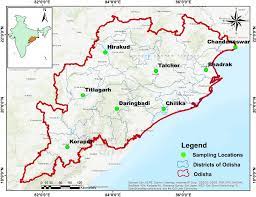
High concentrations of Cancer-causing Heavy Metals in Odisha's wetlands
High concentrations of Cancer-causing Heavy Metals in Odisha's wetlands
Main Examination: General Studies Question Paper-3
(Environment protection)
October 07, 2023
In News:
- A recent study has revealed high levels of cancer-causing heavy metals in Odisha wetlands.
- Although the water from these wetlands is not used directly for human consumption, but people in nearby communities may indirectly consume heavy metals by consuming various foods such as fish, rice, vegetables and spinach from these wetlands.
- This indirect exposure can lead to the introduction of heavy metals into the food chain and subsequent effects on human health.
Research Objectives
- The research aimed to achieve three primary objectives:
- To investigate the accumulation of heavy metals including lead, chromium, copper and zinc in wetland soils.
- Assessing the ecological risk posed by wetlands within agricultural landscapes.
- To investigate the potential human health risks associated with exposure to lead and chromium.
Study site and sample
- The researchers selected eight wetlands for their study, which included both natural and constructed sites:
- Chandaneshwar, Chilka, Daringbadi, Koraput, Bhadrak, Hirakud, Talcher and Titlagarh.
- A total of 144 samples were collected from these wetlands.
Tests and Results
- The study identified the highest concentrations of lead (51.25 micrograms per gram) and chromium (266 micrograms per gram) in the Hirakud wetlands.
- Bhadrak showed the highest concentration of copper (34.27 micrograms per gram), while Koraput showed higher levels of zinc.
- Higher chromium concentrations were observed at all sites compared to previous studies.
Ecological Risk Assessment:
- An ecological risk assessment, which considered all the tested metals together, revealed that Hirakud had the highest ecological risk index, followed by Talcher, Bhadrak, Titlagarh, Chilka, Chandaneshwar, Koraput and Daringbadi.
Risk of cancer
- Hirakud had the highest carcinogenic risk among adults and children due to industrial development in the area, which led to heavy metal contamination of the soil from effluents. Additionally, the western part of the study area, known for rice production, is facing pollution problems due to soil and pesticide use, increasing the risk of cancer in the local community.
Consciousness
- Increasing awareness of the potential health risks associated with heavy metal exposure is important for public health and environmental protection.
Conservation of Wetlands:
Ramsar Convention
- In 1971, a high-level intergovernmental multi-purpose conference was held at a place called Ramsar (located in Iran on the coast of the Caspian Sea) as a global effort for the conservation of wetlands. Under this, a framework for national action and international cooperation was decided for the conservation and rational use of wetlands and their resources.
- This conference was organized on 2 February 1971. To commemorate this occasion, Wetland Day is celebrated every year on 2 February.
- This agreement came into force in 1975.
- India joined this agreement in 1982.
- The United Nations declared 2021-2030 as the Decade on Ecosystem Restoration with the aim of conserving and restoring terrestrial, aquatic and marine ecosystems.
- montreux record
National level initiatives:
- Wetlands (Conservation and Management) Rules, 2017 have been implemented.
- According to the National Wildlife Action Plan (2002-2016) of the Ministry of Environment, Forest and Climate Change, under the Environment Protection Act, 1986, state governments are mandated to protect wildlife within 10 km of the boundaries of national parks and wildlife sanctuaries. The land falling within should be declared an Environmentally Sensitive Zone (ESZ).
Significance of wetlands
- Wetlands provide resources like food, clean water, fuel and also habitat for aquatic life.
- It helps the environment in the form of conservation of biodiversity, protection from soil erosion and pollution control.
- Wetlands support natural activities like soil formation, nutrient cycling, primary production.
- Wetlands directly promote tourism and indirectly support the livelihood of people.
Conclusion:
- Wetlands are extremely essential for human life. Hence there is a need to carry out effective policies and awareness campaigns to address heavy metal pollution in the wetlands of Odisha.
-----------------------------------
Mains Exam Questions
- What is a wetland? Explain the Ramsar concept of 'appropriate use' in the context of wetland conservation.
- Conservation of wetlands is very important in terms of environmental protection. Discuss.